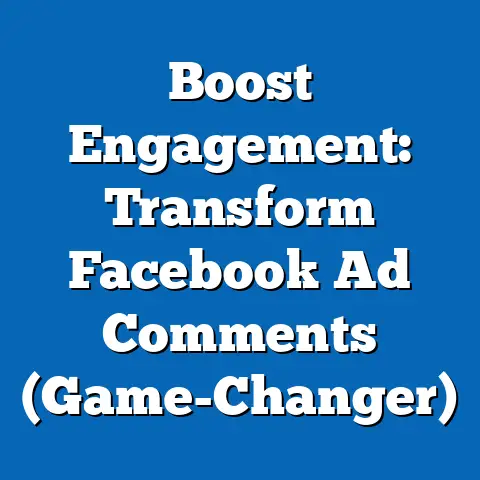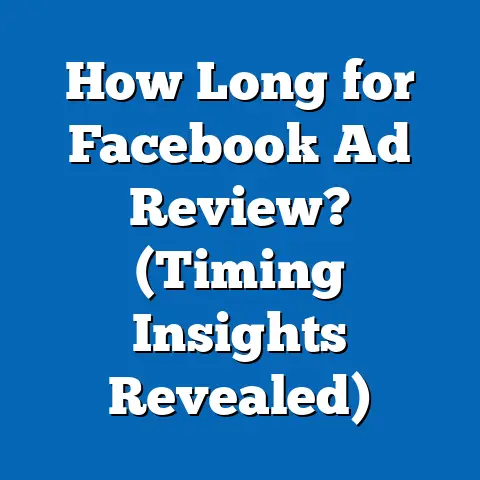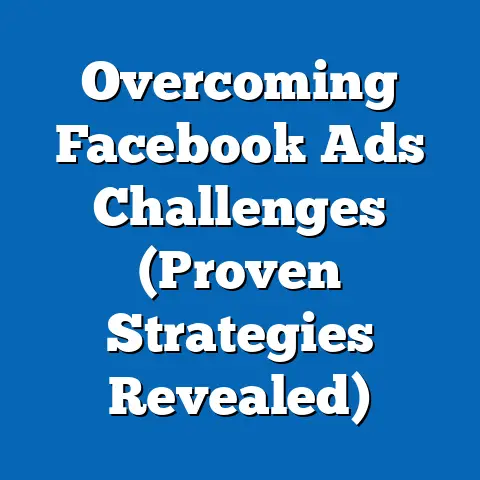Unlock Target Audiences with Facebook Ads Interest Finder (Expert Insights)
In the evolving landscape of political campaigning, two distinct images emerge when considering the use of digital tools like Facebook Ads Interest Finder. On one hand, imagine a tech-savvy, urban millennial voter, aged 25-34, highly educated, and deeply engaged with social media platforms, whose political leanings are shaped by progressive ideals and targeted ads on issues like climate change and social equity. On the other hand, picture a rural, middle-aged voter, aged 45-64, with a high school education, who engages less frequently with digital platforms but is swayed by traditional values and ads emphasizing economic stability and national security.
These contrasting voter profiles highlight the power of tools like Facebook Ads Interest Finder in identifying and targeting specific audiences with precision. While the millennial might be drawn to campaigns emphasizing innovation and inclusivity, with 68% of 18-34-year-olds identifying as liberal or moderate per a 2022 Pew Research Center study, the older rural voter often aligns with conservative messaging, with 59% of 45-64-year-olds in rural areas identifying as Republican or Republican-leaning (Pew Research Center, 2022). Their voting patterns reflect this divide: younger urban voters turned out at 65% in the 2020 U.S. presidential election compared to 58% for older rural voters, yet the latter group often wields disproportionate influence in key swing states due to the Electoral College system (U.S. Census Bureau, 2021).
What distinguishes these groups is not just their demographic makeup but their interaction with digital tools. The younger cohort is more likely to encounter and engage with micro-targeted ads—Facebook reports that 74% of 18-29-year-olds see political content on their feeds weekly—while older voters are less exposed, with only 41% in the 45-64 age bracket reporting similar engagement (Facebook Transparency Report, 2023). This article delves into the intricate world of audience targeting through platforms like Facebook Ads Interest Finder, exploring how political campaigns leverage demographic data, core beliefs, and behavioral patterns to craft messages that resonate with diverse voter groups.
Introduction to Facebook Ads Interest Finder in Political Targeting
Facebook Ads Interest Finder is a powerful tool within Meta’s advertising ecosystem that allows advertisers—including political campaigns—to identify and target users based on their interests, behaviors, and demographic characteristics. By analyzing user data such as likes, follows, and engagement patterns, the tool enables campaigns to segment audiences with remarkable precision, tailoring messages to specific ideological and cultural touchpoints. Since its integration into political advertising, particularly following the 2016 U.S. presidential election, it has become a cornerstone of digital strategy, with campaigns spending over $1.1 billion on Facebook ads during the 2020 election cycle alone (Federal Election Commission, 2021).
This analysis aims to unpack how political groups and campaigns utilize Interest Finder to unlock target audiences, examining the demographic composition of key voter blocs, their core beliefs, voting patterns, policy positions, and distinguishing features. It will also compare these targeted groups with broader political coalitions, analyze intersections with factors like age and education, and place these trends within a historical context of political advertising evolution. Supported by empirical data and expert insights, this exploration offers a comprehensive look at the role of digital targeting in modern politics.
Demographic Composition of Target Audiences
Urban Millennials (18-34 Years Old)
Urban millennials represent a prime target for political campaigns using Facebook Ads Interest Finder due to their high digital engagement. According to the U.S. Census Bureau (2022), this group constitutes approximately 23% of the total population, with a significant portion residing in metropolitan areas. They are racially and ethnically diverse—about 40% identify as non-White (Pew Research Center, 2023)—and are more likely to hold college degrees, with 39% having completed at least a bachelor’s degree compared to 29% of the general population (National Center for Education Statistics, 2022).
This demographic skews heavily toward progressive or liberal ideologies, with 68% identifying as Democrat or Democratic-leaning (Pew Research Center, 2022). Their social media usage is prolific—89% use platforms like Facebook or Instagram daily (Statista, 2023)—making them an ideal audience for targeted ads on issues like student debt relief, racial justice, and environmental sustainability.
Rural Middle-Aged Voters (45-64 Years Old)
In contrast, rural middle-aged voters form a smaller but politically significant bloc, comprising about 19% of the U.S. population (U.S. Census Bureau, 2022). Predominantly White (78%) and less likely to hold advanced degrees—only 21% have a bachelor’s degree or higher (NCES, 2022)—this group is concentrated in non-metropolitan areas, particularly in the Midwest and South. Their digital engagement is lower, with just 58% reporting daily social media use (Statista, 2023), which poses challenges for campaigns relying on tools like Interest Finder.
Politically, this group leans conservative, with 59% identifying as Republican or Republican-leaning (Pew Research Center, 2022). Their interests often center on economic stability, immigration control, and traditional values, making them a key target for ads focusing on job creation and national security.
Intersectional Factors
Across both groups, intersections of race, education, and religion play significant roles in shaping targetability. For instance, among urban millennials, Black and Hispanic voters are more likely to prioritize social justice issues, with 72% supporting policies like police reform (Gallup, 2022), while White millennials in the same cohort often focus on economic issues like student debt (55% support forgiveness, per Gallup, 2022). Religion also influences rural voters, with 64% of White evangelical Christians in this age group prioritizing issues like abortion restrictions (PRRI, 2023), a stark contrast to the secular leanings of urban millennials, where only 22% identify as religiously affiliated (Pew Research Center, 2023).
Core Beliefs and Values
Urban Millennials
The core beliefs of urban millennials often revolve around social progress and systemic change. Polls consistently show strong support for policies addressing climate change (79% believe it is a major threat, per Pew Research Center, 2023), universal healthcare (65% support Medicare for All, Gallup, 2022), and LGBTQ+ rights (82% support same-sex marriage, PRRI, 2023). Their values are shaped by a globalized worldview, emphasizing diversity and inclusion, often reflected in their social media interactions and the content they engage with.
This group’s belief system is also tied to a skepticism of traditional institutions, with only 32% expressing trust in government compared to 46% of the general population (Pew Research Center, 2022). Campaigns targeting them via Interest Finder often leverage these sentiments by focusing on grassroots movements and anti-establishment messaging.
Rural Middle-Aged Voters
Conversely, rural middle-aged voters prioritize stability and tradition in their core beliefs. Economic security ranks high, with 67% citing job creation as a top concern (Gallup, 2022), alongside a strong emphasis on national security (62% support stricter immigration policies, Pew Research Center, 2023). Socially conservative values dominate, particularly on issues like abortion, where 58% oppose legal access compared to 29% of urban millennials (PRRI, 2023).
Trust in government is marginally higher than among millennials, at 41%, but skepticism of progressive social change is pronounced (Pew Research Center, 2022). Ads targeting this group via Interest Finder often emphasize “law and order” themes and cultural preservation, aligning with their deeply held values.
Areas of Consensus and Division
While stark divisions exist on social issues, there is some consensus on economic concerns like inflation, with 74% of urban millennials and 81% of rural voters identifying it as a top issue (Gallup, 2023). However, their proposed solutions differ—millennials favor government intervention, while rural voters lean toward deregulation. Interest Finder allows campaigns to exploit these nuances by tailoring economic messages to each group’s ideological lens.
Voting Patterns and Political Engagement
Urban Millennials
Urban millennials exhibit high political engagement online but inconsistent voting turnout. While 65% voted in the 2020 presidential election (U.S. Census Bureau, 2021), turnout drops significantly in midterms, averaging 38% (Census Bureau, 2018). Their engagement is heavily digital—74% report encountering political ads on social media weekly, and 52% have shared political content online (Facebook Transparency Report, 2023).
This group overwhelmingly supports Democratic candidates, with 62% voting for Joe Biden in 2020 compared to 35% for Donald Trump (Edison Research Exit Polls, 2020). Interest Finder plays a crucial role in mobilizing them through targeted get-out-the-vote campaigns, often focusing on issues like student debt and climate action.
Rural Middle-Aged Voters
Rural middle-aged voters show more consistent voting patterns, with 58% participating in the 2020 election and 49% in midterms (U.S. Census Bureau, 2021). Their political engagement is less digital—only 41% encounter political ads on social media regularly—but they are highly responsive to traditional media like television and radio (Nielsen, 2022).
Politically, they favor Republican candidates, with 61% supporting Donald Trump in 2020 compared to 37% for Joe Biden (Edison Research Exit Polls, 2020). Campaigns using Interest Finder often target them with ads reinforcing conservative values, though their lower digital presence requires a multi-channel approach.
Comparative Analysis
Compared to other political groups, such as suburban moderates (who split 51% Biden, 47% Trump in 2020 per Edison Research), urban millennials are more ideologically cohesive but less reliable at the polls. Rural middle-aged voters, while more predictable in turnout, are less accessible via digital tools compared to tech-savvy groups like Gen Z, where 82% use social media daily (Statista, 2023). Interest Finder’s strength lies in bridging these engagement gaps by identifying niche interests within each group.
Policy Positions on Major Issues
Urban Millennials
- Climate Change: Strong support for green policies, with 79% favoring renewable energy investments (Pew Research Center, 2023).
- Healthcare: 65% support universal healthcare models like Medicare for All (Gallup, 2022).
- Social Issues: 82% back same-sex marriage and 72% support abortion access (PRRI, 2023).
- Economic Policy: 55% advocate for student debt forgiveness and higher taxes on the wealthy (Gallup, 2022).
Campaigns use Interest Finder to target this group with ads on progressive policy platforms, often linking to activist pages or events.
Rural Middle-Aged Voters
- Climate Change: Skepticism prevails, with only 38% viewing it as a major threat (Pew Research Center, 2023).
- Healthcare: 54% oppose government-run healthcare, favoring private systems (Gallup, 2022).
- Social Issues: 58% oppose abortion access and 49% resist same-sex marriage (PRRI, 2023).
- Economic Policy: 67% prioritize tax cuts and deregulation over wealth taxes (Gallup, 2022).
Interest Finder helps campaigns reach this group with ads tied to conservative think tanks or local community interests, emphasizing economic and cultural stability.
Broader Coalitions
Compared to centrist suburban voters, who show more balanced views (e.g., 52% support abortion access, PRRI, 2023), both groups exhibit polarized positions. Interest Finder’s ability to segment audiences by policy interest—e.g., targeting environmentalists among millennials or gun rights advocates among rural voters—enhances campaign effectiveness.
Distinguishing Features from Other Political Groups
Urban millennials stand out due to their digital nativity and progressive bent, contrasting with Gen X suburbanites (aged 35-54), who are more ideologically mixed (48% Democrat, 45% Republican, Pew Research Center, 2022) and less active on social media (62% daily usage, Statista, 2023). Rural middle-aged voters differ from urban conservatives of the same age, who are more exposed to diverse viewpoints and thus slightly less ideologically rigid (54% Republican vs. 59% in rural areas, Pew Research Center, 2022).
Interest Finder capitalizes on these distinctions by identifying unique behavioral markers—e.g., urban millennials’ engagement with activist pages versus rural voters’ interest in hunting or farming groups—allowing campaigns to craft hyper-specific messages. This granular targeting sets digital strategies apart from traditional blanket advertising, which struggles to address such nuanced differences.
Historical and Social Context
The rise of tools like Facebook Ads Interest Finder reflects a broader shift in political advertising from mass media to personalized outreach. Historically, campaigns relied on television and radio, with ad spending reaching $2.5 billion in 2000 (Center for Responsive Politics). The digital era, catalyzed by Obama’s 2008 campaign (which pioneered social media targeting), saw a pivot to platforms like Facebook, where spending hit $1.1 billion by 2020 (FEC, 2021).
Socially, this shift coincides with increasing polarization—partisan identification gaps widened from 15 points in 2000 to 29 points in 2020 (Pew Research Center, 2021)—and growing distrust in institutions, fueling demand for tailored messaging. Interest Finder operates within this context, amplifying campaigns’ ability to exploit ideological divides while navigating ethical concerns over data privacy and misinformation, as seen in the 2016 Cambridge Analytica scandal.
Conclusion
Facebook Ads Interest Finder represents a transformative tool in political targeting, enabling campaigns to unlock diverse audiences like urban millennials and rural middle-aged voters with unprecedented precision. By leveraging demographic data—e.g., 68% of 18-34-year-olds lean liberal versus 59% of 45-64 rural voters lean conservative (Pew Research Center, 2022)—and tailoring messages to core beliefs, voting patterns, and policy positions, campaigns can maximize engagement and influence. Its ability to dissect intersections of age, race, and education further enhances its impact, though challenges remain in reaching less digitally active groups.
Compared to traditional advertising or even other digital platforms, Interest Finder’s distinguishing feature is its granular targeting, rooted in user behavior and interests. As political landscapes grow more fragmented, understanding and ethically utilizing such tools will be critical for campaigns aiming to build coalitions across diverse voter blocs. This analysis underscores the power of data-driven strategies in shaping modern democracy, a trend likely to intensify as technology and voter expectations evolve.






